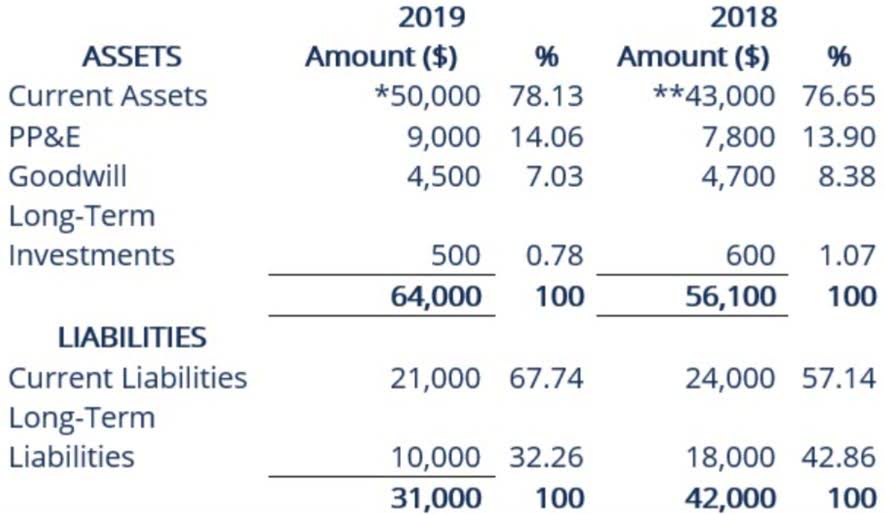
Accelerate your planning cycle time and budgeting process to be prepared for what’s next. Connect and map data from your tech stack, including your ERP, CRM, HRIS, business intelligence, and more.

From Data Overload to Better Business Decisions: Optimize Your BP&F with Power BI and Excel
- Use the insights gained from the vertical analysis in your decision-making processes.
- By dividing net income by total assets, stakeholders can gauge the effectiveness of the company’s asset utilization.
- Financial statements that include vertical analysis clearly show line item percentages in a separate column.
- Vertical analysis is a powerful tool for financial statement analysis that allows for a deeper understanding of a company’s financial composition.
- Like its title, investing activities include cash flows involved with firm-wide investments.
- When doing comprehensive financial statement analysis, analysts typically use multiple years of data to facilitate horizontal analysis.
- This shows each cash outflow or inflow as a percentage of the total cash inflows of the business.
While vertical analysis cannot answer why changes have taken place, it’s a useful tool for trend analysis along with pinpointing areas that need further investigation. Analysis of the balance sheet can take many forms, with vertical analysis just one of them. To complete a vertical analysis, you’ll first need to determine what information you’re looking to obtain. Both assets and liabilities/equity have a base number assigned, which is always 100%. If your vertical analysis reveals https://www.bookstime.com/ unusual trends or variances, take the time to investigate these changes. Horizontal analysis also displays percentage change for each balance sheet item as well.
- Vertical analysis of a balance sheet can be a powerful tool to understand your company’s performance or how two businesses compare.
- This helps in assessing relative profitability, efficiency and competitiveness among other factors over time.
- By analyzing these profitability ratios using vertical analysis, you can gauge a company’s financial performance and compare it to industry benchmarks or previous periods.
- This change could be driven by higher expenses in the production process, or it could represent lower prices.
How Vertical Analysis Helps In FP&A

Let us understand the advantages of vertical analysis equation through the points below. For example, the amount of cash reported on the balance sheet on Dec. 31 of 2024, 2023, 2022, 2021, and 2020 will be expressed as a percentage of the Dec. 31, 2020, amount. If 5% of company revenue was generated through currency movements, and an additional 5% was generated from a business normal balance unit with just one client, those represent significant risks to the business. She earned her Bachelor’s in Business Administration from the University of Wisconsin and currently resides in Minneapolis, Minnesota. Cube’s AI automates the heavy lifting, letting your finance team focus on strategic insights. Looking to streamline your business financial modeling process with a prebuilt customizable template?
Multi-year comparisons
- FP&A leaders gain insights into financial ratios specific to their business, enabling them to assess whether they’re appropriate for the company’s long-term financial health.
- We can also view from this table that marketing expenses as a percentage of total sales increased to 8% as a percentage of total sales in year 3, compared to 6% in year 2.
- In this guide, we explored the methodology of vertical analysis, walked through the steps to perform vertical analysis on income statements, balance sheets, and cash flow statements.
- Vertical analysis can highlight these issues, giving executives the opportunity to make strategic moves to reduce or eliminate them.
We’ll dive into the methodology of vertical analysis and walk you through the step-by-step process of conducting a vertical analysis. By the end of this guide, you’ll be equipped with the knowledge to interpret vertical analysis results and apply them in practical scenarios. Vertical analysis can provide business owners and CFOs with valuable information, particularly when used with additional financial ratio analysis. By looking at the balance sheet, you can see that the majority of your company’s assets are current, with only 25% of assets considered fixed, or long-term assets. Typically used for a single accounting period, vertical analysis is extremely useful for spotting trends.

Deeper composition insights
Understanding vertical balance sheets is crucial for stakeholders who need clear insights into an organization’s vertical analysis formula financial health. They facilitate easier analysis of financial ratios, which are essential for evaluating performance and making informed decisions. Companies use the balance sheet, income statement, and cash flow statement to manage the operations of their business and to provide transparency to their stakeholders. All three statements are interconnected and create different views of a company’s activities and performance. Three of the most important techniques are horizontal analysis, vertical analysis, and ratio analysis.
